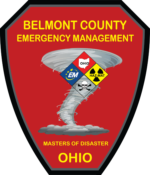What Is EMA?
Established under Chapter 5502 of the Ohio Revised Code, the Ohio Emergency Management Agency is the central point of coordination within the state for response and recovery to disasters. The primary focus of the agency when not in a response or recovery mode is to ensure that the state, and the 11.6 million citizens residing in it, are prepared to respond to an emergency or disaster and to lead mitigation efforts against the effects of future disasters.
Effective emergency management systems are a tiered effort. When an emergency exceeds the capacity of local government, they request the assistance of the state through the Ohio EMA. If an emergency exceeds the capacity of the State, aid is requested from the president through the Federal Emergency Management Agency. To ensure preparedness and the capability to respond at all levels, it is critical that Ohio EMA’s 95 person staff interface regularly with their local and federal counterparts.
During an emergency response or recovery effort, all sections and branches are focused on the event. The Ohio EMA, as the governor’s emergency management organization, may activate the Ohio Emergency Operations Center to better coordinate the state’s response.
Chapter 5502 of the ORC designates the Executive Director of the Ohio EMA as the state coordinator during emergency response and stipulates that the Executive Director:
“Shall coordinate all activities of all agencies for emergency management within the state, shall maintain liaison with similar agencies of other states and of the federal government, shall cooperate with those agencies subject to the approval of the governor, and shall develop a statewide emergency operations plan that shall meet any applicable federal requirements for such plans.”
Ohio EMA’s current staffing roster includes:
- Five Regional Field Offices, each manned with regional supervisors and emergency management specialists. The regional offices are located in Hancock County (NW), Cuyahoga County (NE), Franklin County (Central), Jackson County (SE), and Butler County (SW).
- The EMA Watch Office, staffed by two branch chiefs and eight analysts, is operational 24 hours a day, seven days a week, and is charged with increasing Ohio EMA and the State Emergency Operations Center’s speed and efficiency, enabling the state to better prepare and respond to all hazards.
The agency also has trainers who specialize in all-hazards training, exercise design, survivable crisis management, and radiological training. These individuals support all 88 county emergency management programs.
EMA HISTORY TIMELINE IN OHIO
1950’s Civil Defense began in Ohio under the direction of Gov. Frank J. Lausche.
April 3, 1974 – An F-5 tornado ripped through the of Xenia Ohio killing 33 people and injuring more than 1,300.
1977 – Gov. James A. Rhodes changed Civil Defense’s name to Disaster Services Agency. Richard M. Lockhart was named Director.
February 1978 – 12 – 14 inches of new snow fell across Ohio, on top of up to 2 feet that had fallen just days earlier. Winds of 50 to 70 mph made for minus 70 degree wind chill factor during the “Blizzard of ’78.”
February 1978 – Gov Rhodes declared a state of emergency and activated the State Emergency Operations Center and ordered it staff by cabinet-level representatives, the first such activation of the EOC.
1988 – The Ohio Adjutant General renamed the Disaster Services Agency to the Ohio Emergency Management Agency (Ohio EMA). Dale Shipley is named Director.
June 14, 1990 – Heavy rains and severe storms hit Shadyside and Belmont County, giving the National Weather Service no time to upgrade its flood watch to a warning. Twenty-six people were killed, around 80 homes were destroyed, with another 250 damaged.
1990 – As a result of the deadly Shadyside flood, the Ohio General Assembly directed the Ohio EMA to develop a flood warning system. The result of this initiative is the State of Ohio Rain/Snow Monitoring System (STORMS) an automated rain gauge system that monitors snow and rainfall for potential flooding, transmitting real-time precipitation data to the Ohio EMA in Columbus and to the National Weather Service.
2016 – Ohio Watch Office created within the Ohio EMA, which provides daily situational awareness to Ohio EMA, its partners, and stakeholders throughout the state.
PRESIDENTIAL DISASTER DECLARATIONS FOR BELMONT COUNTY
Many times declarations are tied in with other incidents around the State of Ohio
Declaration Date Reason
March 24, 1964 Heavy rains and flooding
July 19, 1972 Storms and flooding
September 11, 1975 Flood
January 26, 1978 Severe blizzard conditions
August 23, 1980 Heavy rains and flooding
June 6, 1990 Severe storms, tornadoes, and flooding
August 14, 1992 Severe storms, tornadoes, and flooding
January 27, 1996 Ohio River flooding
June 24, 1996 Severe storms and flooding
June 30, 1998 Flash flooding, flooding, high winds and tornadoes
January 26, 2004 Landslide, severe storms
September 19, 2004 Severe storms and flooding
February 15, 2005 Severe winter storms , ice and mudslides
Sept 13, 2005 Hurricane Katrina Evacuation
July 12, 2011 Severe Storms and Flooding
June 30, 2012 Severe Storms
August 20, 2012 Severe Storms and Straight-line Winds
April 17, 2018 Severe Storms, Landslides, and Mudslides
April 8, 2019 Severe Storms, Flooding and landslides
